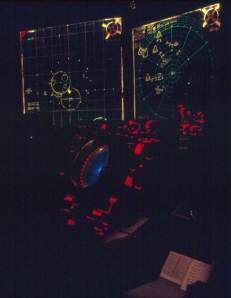 Where I worked was called CIC. This area was manned by those with a rating of Radarman (RD). This rating was changed to OS (Operations Specialist) in October of 1972. We were part of the OI (Operations Intelligence) Division which also included Radiomen, Electronic Technicians, Quartermasters and Signalmen. The job in CIC was multifaceted and included operation of radar (both air and surface), aid in navigation, detect, plot and track friendly as well as hostile targets, communicate with other vessels and basically provide information. Collection, analyzing, processing, display and dissemination of tactical information and intelligence is essentially what we did. There was a reason that we were located just a few steps from the Captains stateroom and had a direct stairway to the bridge. The skipper, the XO or the OOD (Officer of the Deck) could step in CIC anytime and see the big picture of what is going on around us through the use of status boards. These were steel-framed sheets of acrylic or plexiglass that were edge-lit and displayed information. The room was always dark when underway, with nothing but red lights overhead to protect night vision. The status boards stood out brightly in that environment. They would be written on from the back with yellow grease pencils then when viewed from the front, with the edge-lighting, lit up like neon. We had terry rags with which to erase the marks off the panel. Sometimes when at GQ and manning our battle stations I would be assigned to the large status board that displayed the Viet Nam coastline and we would plot various positions of other vessels in the fleet on it. Of course, for the writing or plots to be correctly visible in the room you had to write backwards from the back of this board. You worked from the back of the board so that the information was never obscured from the front. I can still quickly write backwards to this day! Some things just don’t go away. Working with legible logs and sometimes having to jot down codes, I got into a habit of modifying how I print zeros, 1’s, and Z’s to save any confusion. I still sometimes do this to this day, though I’ve never run the slash through a 7.
Where I worked was called CIC. This area was manned by those with a rating of Radarman (RD). This rating was changed to OS (Operations Specialist) in October of 1972. We were part of the OI (Operations Intelligence) Division which also included Radiomen, Electronic Technicians, Quartermasters and Signalmen. The job in CIC was multifaceted and included operation of radar (both air and surface), aid in navigation, detect, plot and track friendly as well as hostile targets, communicate with other vessels and basically provide information. Collection, analyzing, processing, display and dissemination of tactical information and intelligence is essentially what we did. There was a reason that we were located just a few steps from the Captains stateroom and had a direct stairway to the bridge. The skipper, the XO or the OOD (Officer of the Deck) could step in CIC anytime and see the big picture of what is going on around us through the use of status boards. These were steel-framed sheets of acrylic or plexiglass that were edge-lit and displayed information. The room was always dark when underway, with nothing but red lights overhead to protect night vision. The status boards stood out brightly in that environment. They would be written on from the back with yellow grease pencils then when viewed from the front, with the edge-lighting, lit up like neon. We had terry rags with which to erase the marks off the panel. Sometimes when at GQ and manning our battle stations I would be assigned to the large status board that displayed the Viet Nam coastline and we would plot various positions of other vessels in the fleet on it. Of course, for the writing or plots to be correctly visible in the room you had to write backwards from the back of this board. You worked from the back of the board so that the information was never obscured from the front. I can still quickly write backwards to this day! Some things just don’t go away. Working with legible logs and sometimes having to jot down codes, I got into a habit of modifying how I print zeros, 1’s, and Z’s to save any confusion. I still sometimes do this to this day, though I’ve never run the slash through a 7.
On any Navy ship the CIC is often referred to as the nerve center of the ship. For all the information flowing in and out of here, you would think we knew all of what is going on, but it wasn’t always so. We would be in the dark figuratively as well as literally. After having
Read more…



 Posted by dennisclevenger
Posted by dennisclevenger 

